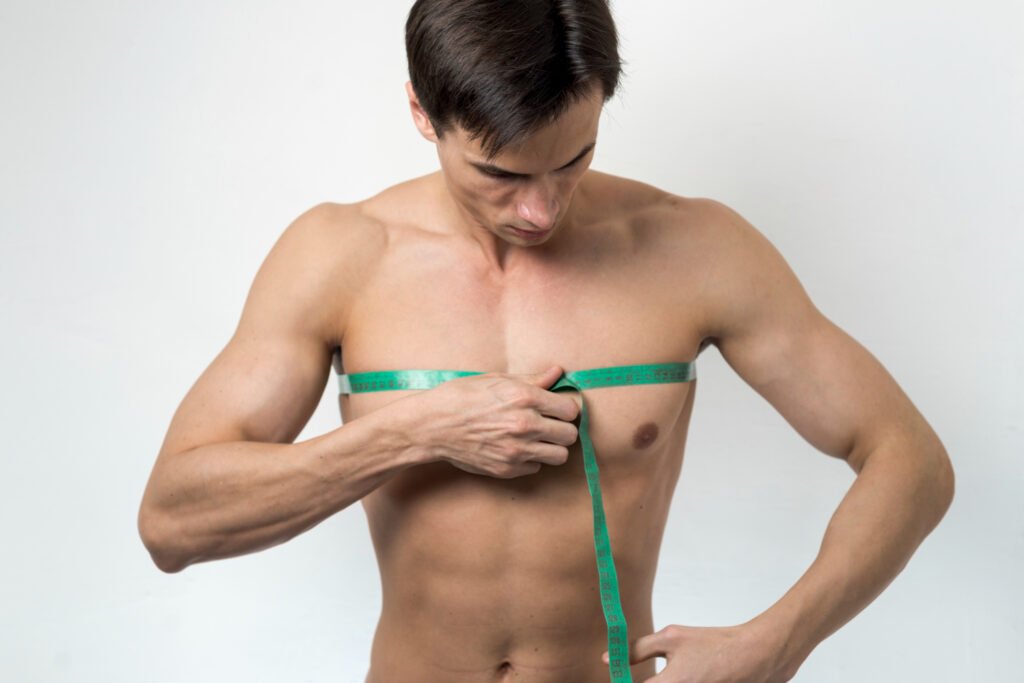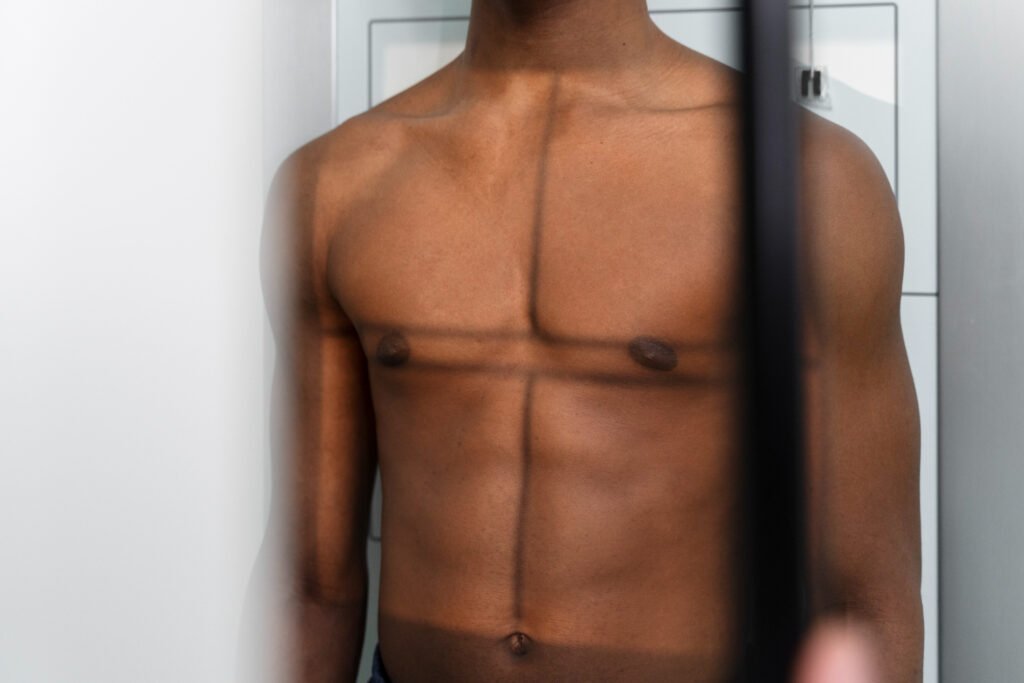Gynecomastia Surgery in Gurugram – Safe & Effective Male Breast Reduction
At our advanced clinic in Sector 85, Gurugram, we offer expert gynecomastia surgery to help men regain a confident, masculine chest through safe, minimally invasive procedures.

What is Gynecomastia?
Gynecomastia is a condition where male breast tissue becomes enlarged, usually due to hormonal imbalances. It can affect one or both sides of the chest and is often mistaken for fat buildup. This condition is common in adolescents and older men but can occur at any age.
Symptoms and When to See a Doctor
Common symptoms include:
- Swollen or firm chest tissue
- Breast tenderness
- Uneven chest appearance
- Emotional discomfort or social embarrassment
If these symptoms are persistent or affecting your confidence, it’s time to consult a specialist.

What Causes Male Breast Enlargement?
Gynecomastia can result from:
- Hormonal changes (testosterone/estrogen imbalance)
- Use of steroids or bodybuilding supplements
- Side effects of medications (antidepressants, anti-anxiety drugs, etc.)
- Liver or kidney disease
- Obesity and poor lifestyle habits
Gynecomastia vs. Pseudogynecomastia
- Gynecomastia involves glandular tissue enlargement.
- Pseudogynecomastia is due to excess fat in the chest area.
A proper diagnosis helps decide the right treatment path.
Who is the Right Candidate for Surgery?
You may be eligible if:
- You’re physically healthy and at a stable weight
- Non-surgical treatments haven’t worked
- Your chest enlargement has lasted more than 12 months
- You’re not suffering from any underlying hormonal disorder
Cost of Gynecomastia Surgery in Gurugram
The average cost ranges from ₹45,000 to ₹90,000, depending on:
- Severity of the condition
- Type of surgical procedure
- Use of anesthesia
EMI and easy installment options are available.
Contact us for a personalized quote based on your case.
The Gynecomastia Surgery Procedure
We use one or both of the following techniques:
- Liposuction: To remove fatty tissue
- Excision: To remove excess glandular tissue or skin
The procedure is typically done under local or general anesthesia and takes 1–2 hours.
Benefits of Gynecomastia Surgery
- Flatter, firmer, and more masculine chest
- Improved self-esteem and posture
- Freedom to wear fitted clothes or go shirtless
- Long-lasting results with proper lifestyle
Risks and Side Effects
Like any surgery, gynecomastia surgery carries some risks, such as:
- Mild swelling or bruising
- Temporary numbness
- Minor scarring
These are usually short-term and manageable with proper care.
Recovery and Aftercare
- You can return to work in 2–3 days
- Avoid heavy exercise for 2–3 weeks
- Wear a compression garment for better healing
- Follow all doctor-prescribed medications and hygiene instructions
Full results are typically visible within 6–12 weeks.
Our Treatments & Solutions
Medical Weight Loss Programs
Customized diet and lifestyle plans supported by prescription therapies to help you lose fat, not muscle.
- Benefits: Sustainable results, reduced cravings, improved metabolism.
Ozempic Weight Loss
A GLP-1-based injectable clinically shown to reduce appetite and support long-term weight loss.
- Benefits: Doctor-guided, great for overweight/obesity-related conditions.
Mounjaro Weight Loss
Advanced weight management injection with dual action for insulin regulation and fat reduction.
- Benefits: Powerful fat reduction, appetite control, and blood sugar support.
Cryolipolysis (Fat Freezing)
Destroys stubborn fat cells using controlled cooling – no surgery, no downtime.
- Benefits: Non-invasive, long-lasting fat reduction in target areas.
Liposuction
Surgical fat removal for faster and dramatic contouring of abdomen, thighs, arms, and more.
- Benefits: Instant inch loss, ideal for resistant fat.
Viora RF Body Contouring
Radiofrequency-based tightening and sculpting for body and face.
- Benefits: Firms loose skin, improves texture, and reduces cellulite.
Cellulite Treatment
Techniques like vacuum RF, acoustic wave therapy, and mesotherapy to smooth dimpled skin.
- Benefits: Improves skin texture, breaks down fibrous fat bands.
Body Shaping
Combination of fat reduction, skin tightening, and toning through customized technologies.
- Benefits: Defined silhouette, waistline correction, non-surgical approach.
Lipolysis Injections
Fat-dissolving injections (e.g., Kybella) to reduce double chin, flanks, or abdomen bulges.
- Benefits: Precise contouring, no anesthesia required.
Surgical & Aesthetic Enhancements
Blepharoplasty (Eyelid Surgery)
Corrects droopy lids, under-eye bags, or hooded eyes for a youthful look.
- Benefits: Brighter eyes, rejuvenated facial appearance.
Face Lift
Lifts and tightens sagging skin for a youthful facial contour.
- Benefits: Natural-looking, long-term results.
Dimple Creation
Minimally invasive procedure for natural-looking dimples.
- Benefits: Quick, scarless enhancement.
Gynecomastia Surgery
Male breast reduction to remove excess fat and gland tissue.
- Benefits: Improved chest contour, confidence boost.
Breast Augmentation
Implants or fat transfer to enhance breast volume and shape.
- Benefits: Symmetry correction, fuller bust.
Breast Reduction
Surgical size reduction for health, comfort, and aesthetics.
- Benefits: Back pain relief, better posture, improved proportion.
Feminine Wellness
Vaginal Tightening
Laser or RF-based treatments to enhance firmness and elasticity.
- Benefits: Improved confidence, urinary control, intimate wellness.
Hymenoplasty
A minor surgical procedure to restore the hymen for personal or cultural reasons.
- Benefits: Safe, discreet, and doctor-led.
Ear & Nose Piercing
Medical-grade piercing services using sterilized equipment.
- Benefits: Painless, infection-free procedure with perfect symmetry.
Meet Your Experts
Our lead doctor, is a certified dermatologist with 10+ years of experience. The team ensures safe, ethical, and effective care in every session.
Book a Free Hair Consultation Today
Let our experts guide you toward the right treatment.
📞 Call/WhatsApp: 9220229223
📍 Visit us: Clinic at Sector 85, Gurugram (Near Sapphire 85 Mall)
Why Choose Wellness Story
FAQs
A. The surgery is done under anesthesia. Post-surgery discomfort is mild and temporary.
A. Yes, if you maintain a healthy lifestyle and avoid hormone-altering substances
A. Usually not, as it is considered a cosmetic procedure. But some exceptions apply—check with your insurer.
A. Light activities can resume in a few days, but heavy workouts should be avoided for 3–4 weeks.
A. Gynecomastia involves firm, rubbery tissue under the nipple, while fat is soft and spread across the chest. A physical examination and sometimes an ultrasound can confirm the diagnosis.
A. Ideal candidates are generally 18 and older, after puberty, when breast tissue growth has stabilized.
A. In adolescents, it sometimes resolves naturally. In adults, persistent gynecomastia usually requires surgery for permanent correction.
A. Minimal scars are placed in discreet areas (such as the areola edge). They fade significantly over time with proper care.
A. Most patients return to work within 2–3 days if the job is not physically demanding.
A. Exercise may reduce chest fat but cannot eliminate glandular breast tissue, which typically requires surgical removal.
A. Yes, maintaining a healthy diet, avoiding alcohol and steroids, and regular exercise help preserve the results.
A. In most cases, no drains are required. If used, they are removed within 1–2 days post-surgery.
A. Recurrence is rare if the underlying cause is addressed and lifestyle is maintained
A. Avoid smoking, alcohol, and certain medications for 1–2 weeks before surgery. Your surgeon will provide detailed pre-op instructions.



